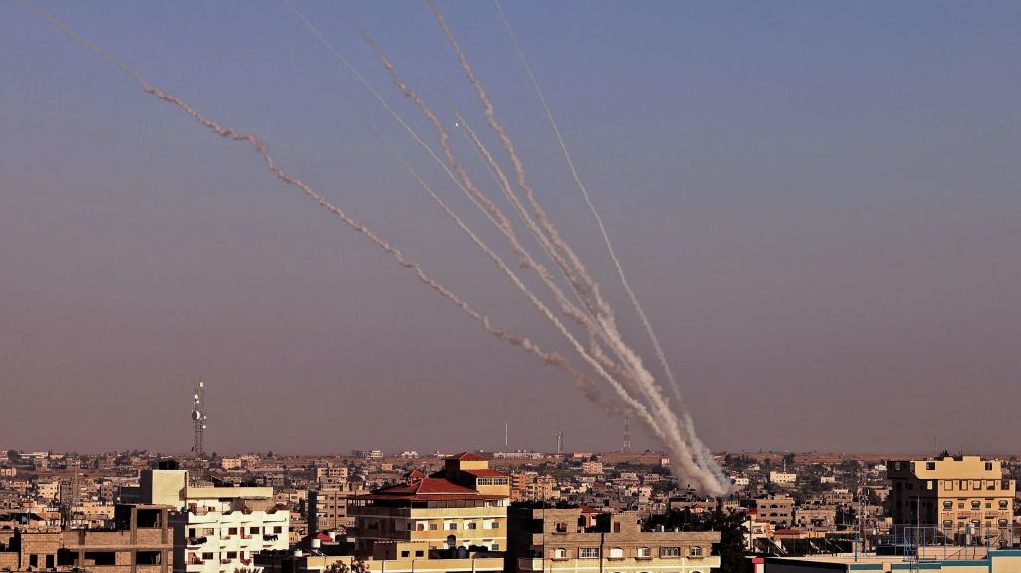Made in Gaza: Hamas Rockets the Product of Foreign Aid and Smuggled Material
Medical equipment and fertilizer among international assistance items repurposed by Hamas to manufacture arms and ammunition using Iranian know-how
Palestinian organizations in the Gaza Strip have fired at least 1,300 missiles at Israeli communities since the current round of violence began on Monday evening, with the numbers continuing to mount. The Iron Dome air defense system intercepted 85%-90% of those headed for populated areas, the Israel Defense Forces said.
At least six civilians in Israel have been slain by the rockets, including an Indian caregiver in Ashkelon, and approximately 100 people wounded. In addition, an anti-tank missile killed a Nahal Brigade sergeant on the Gaza border Wednesday.
Gaza has been under an Israeli-Egyptian blockade since Hamas seized power there in 2007, put into effect to prevent the stockpiling of weapons and ammunition by the terror organizations in the Strip. As part of the blockade, Israel limits and supervises the goods and materials that enter the area.
Egypt also tightly controls the movement of goods and people through the Sinai-Gaza border.
Despite the efforts of both countries, Hamas has come prepared to the current round of violence, armed not only with many more rockets than during the last Gaza war in 2014, but also more accurate weaponry.
Dr. Kobi Michael, a senior research fellow at Tel Aviv University’s Institute for National Security Studies, told The Media Line that experts on the matter “aren’t surprised by the amount of weaponry that they [Hamas] have, nor by the quality of the armaments there [in Gaza], some of which was smuggled in, but the majority of the arsenal is manufactured independently by Hamas based on Iranian knowledge and more than 15 years of experience.”
Col. (res.) Dr. Michael Milshtein, head of the Palestinian Studies Forum at the Moshe Dayan Center for Middle Eastern and African Studies at Tel Aviv University, also says the amount of weaponry held in Gaza is not unexpected. “The quantity isn’t surprising,” he told The Media Line.
This holiday season, give to:
Truth and understanding
The Media Line's intrepid correspondents are in Israel, Gaza, Lebanon, Syria and Pakistan providing first-person reporting.
They all said they cover it.
We see it.
We report with just one agenda: the truth.


Milshtein points instead to the ability to fire large numbers of rockets in rapid succession as the main improvement in Hamas’ capabilities. He attributes this to advancement in the organization’s combat doctrine as a result of studying Israel’s Iron Dome air defense system and its weaknesses.
The Islamist group’s rockets and other military equipment are the product of “a cynical use of material which enters the Strip to aid its recovery and for agricultural uses, in combination with money from Qatar,” Michael said.
The UN and Israel have a joint apparatus to supervise the use of the materials, but as Hamas is in control of the Strip, it has managed to overcome this obstacle. Fertilizer is used to produce explosives, for example, Michael says. In addition, medical equipment is disassembled for parts, and oxygen tanks intended for medical care are repurposed to serve the organization’s military needs.
“There’s a lot of dual use,” Milshtein said. “A lot of things enter Gaza as, for example, utility poles, and they know how to later repurpose them as rockets for a variety of ranges” by using their metal.
The majority of the arsenal is manufactured independently by Hamas based on Iranian knowledge and more than 15 years of experience
Some materials are smuggled into the Strip, be it by land or by sea. “Explosives that they need, machines that have to do with the rockets’ accuracy, and sometimes metal parts that are more difficult to get in Gaza,” he says.
The funding of the organization’s enterprise is not dependent solely on Qatari money but comes also from Tehran, Gazan taxpayers and international aid intended for humanitarian projects, part of which finds its way to Hamas’ pockets, according to Michael.
Israel has responded to Palestinian attacks with airstrikes, targeting “terror targets in the Gaza Strip,” which include Hamas and Islamic Jihad assets and operatives. The attacks have so far resulted in 53 Palestinian deaths, 14 of them children, and 320 wounded, according to the Hamas Health Ministry in Gaza. The IDF reported on Tuesday that it had killed 15 Hamas military leaders, and has not released an updated count since.
Michael believes the Palestinian organizations have thousands of rockets left, enough for “a fair few more days of such fighting.”
Milshtein, in turn, differentiates between long-range projectiles and short-range projectiles. Of the latter, he says, “they can shoot all day long.”
However, Milshtein thinks that Hamas may be nearing the end of its stockpile of long-range missiles, those that can reach Tel Aviv. Wednesday night, he said, would be a telling moment. If Hamas was able to repeat its barrages of hundreds of rockets toward Tel Aviv, it would mean they may have a large number of long-range rockets still stashed away in the Strip. Otherwise, they may be pretty close to the bottom of the pile.

